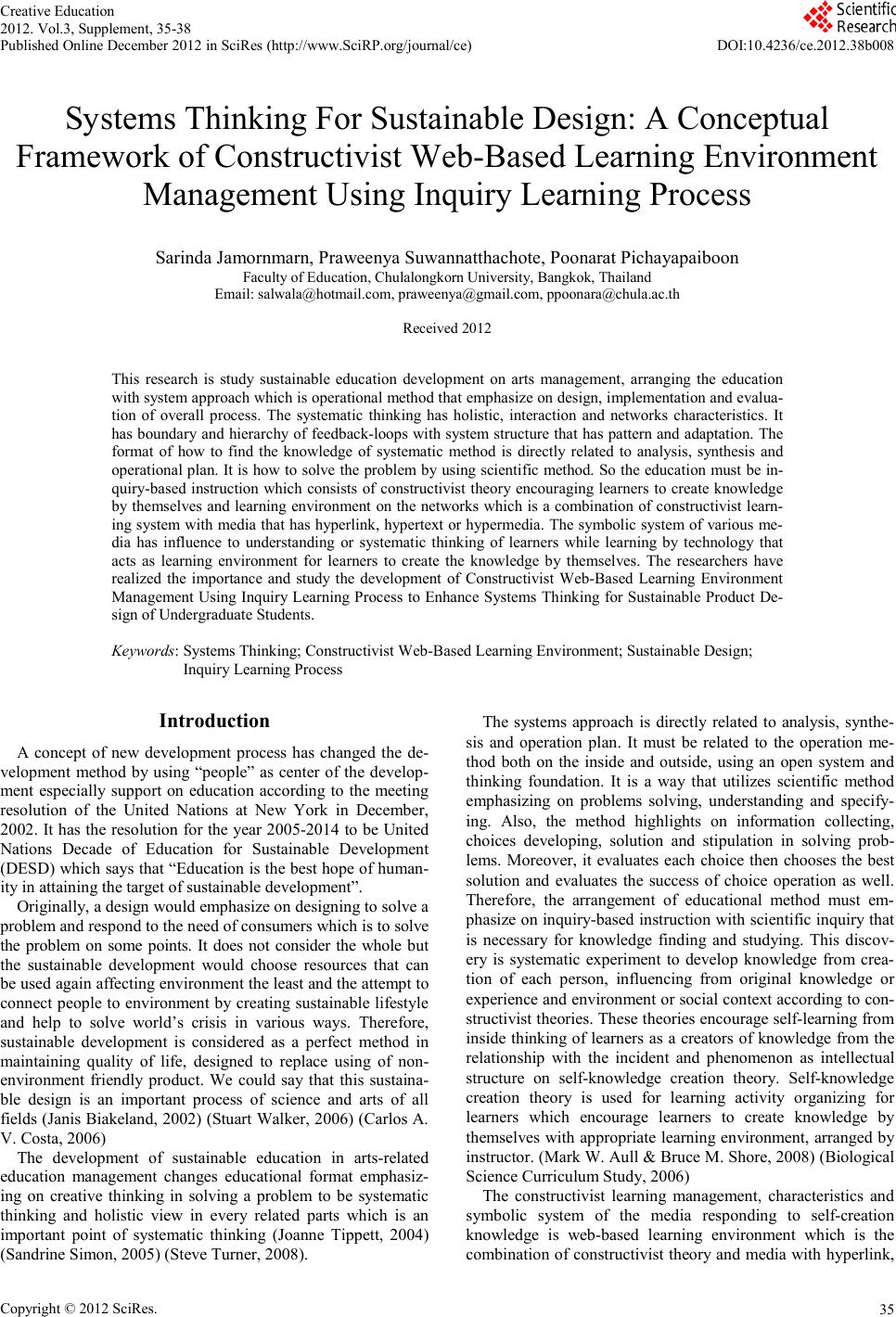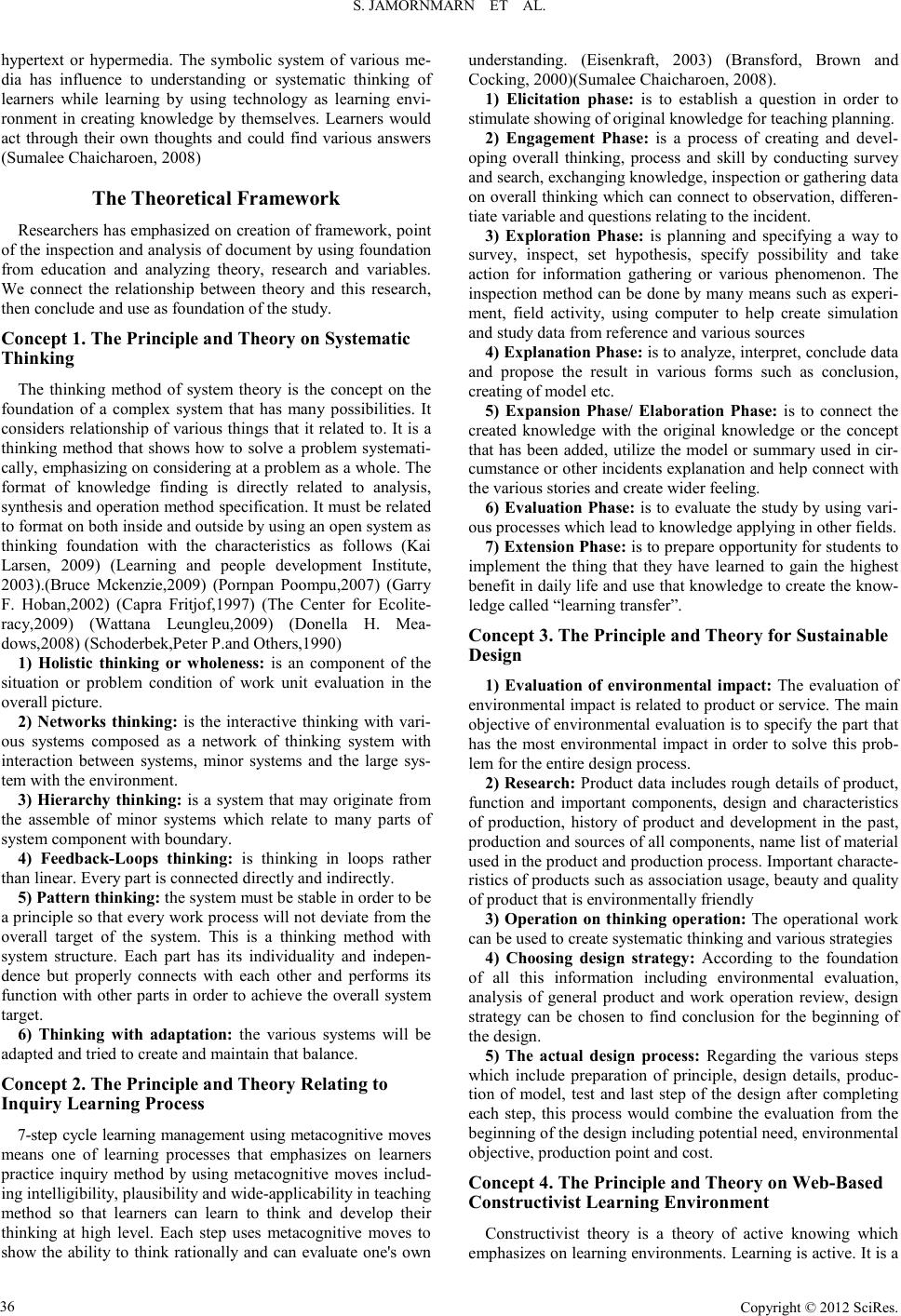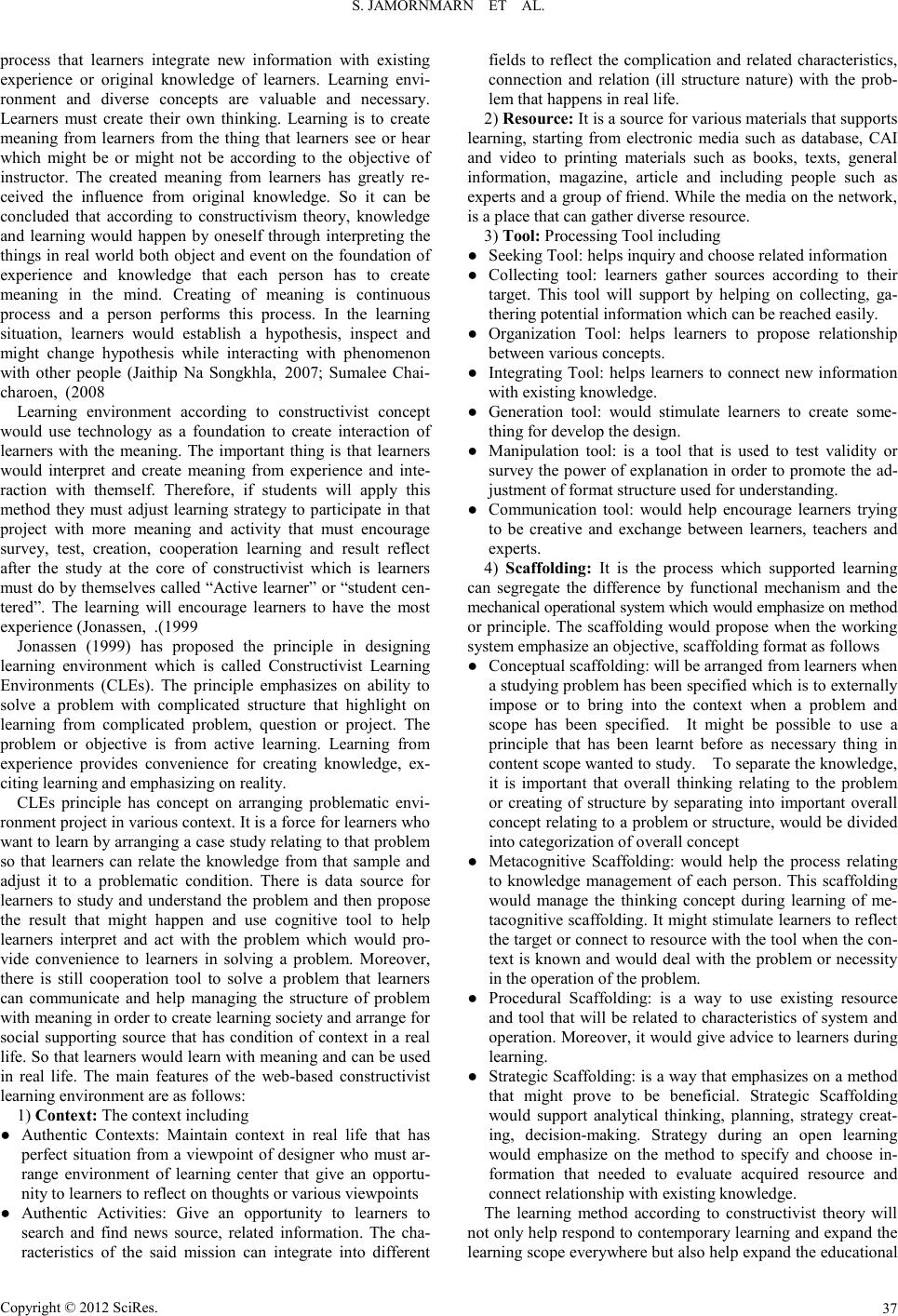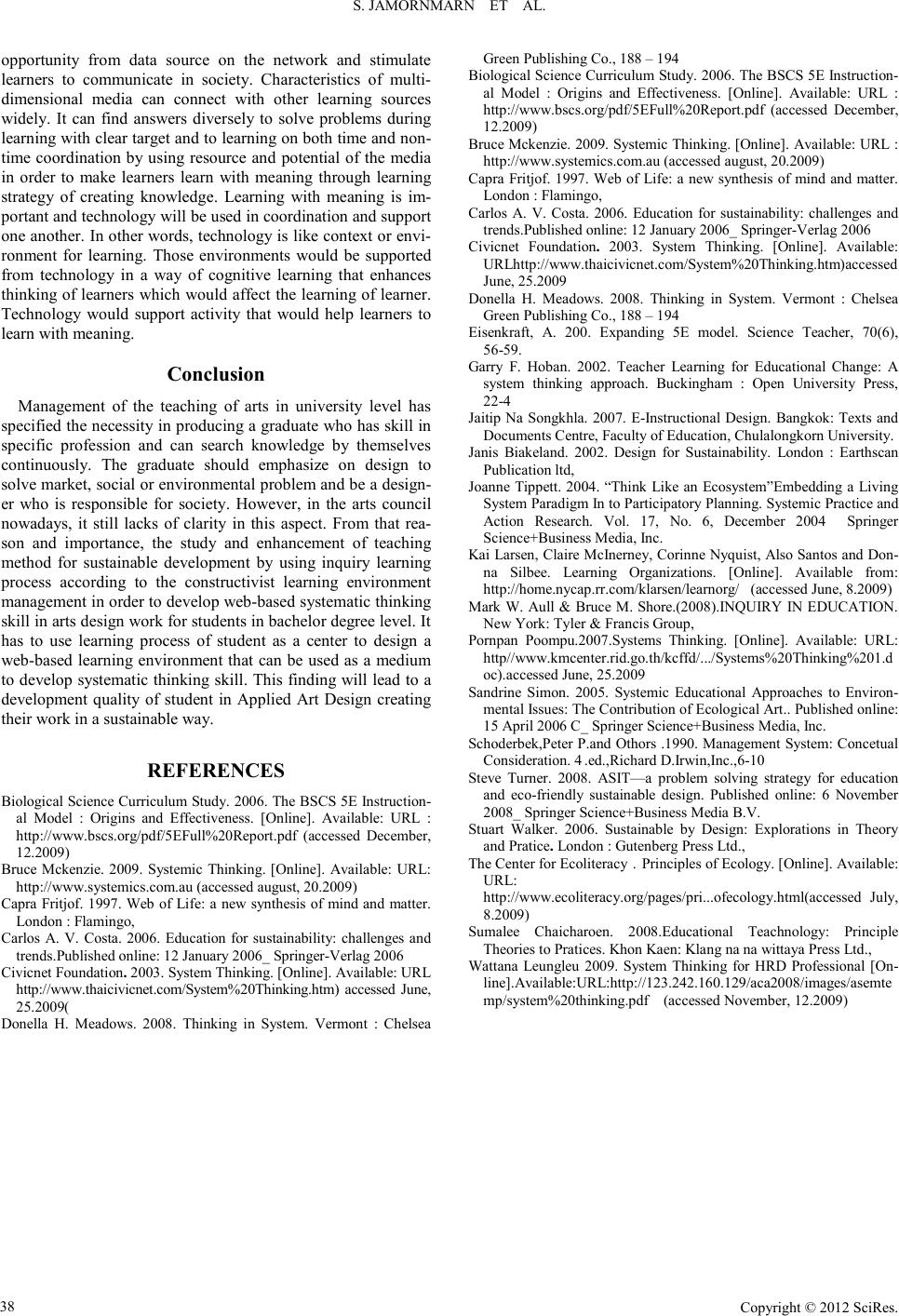Paper Menu >>
Journal Menu >>
 Creat ive Educati on 2012. Vol.3, Supplement, 35-38 Published Online December 2012 in SciRes (http://www.SciRP.org/journal/ce) DO I:10.4236/ce.2012.38b008 Copyright © 2012 SciRes. 35 Systems Thinking For Sustainable Design: A Conceptual Framework of Constructivist Web-Based Learning Environment Management Using Inquiry Learning Process Sarinda Jamornmarn, Praweenya Suwannatthachote, Poonarat Pichayapaiboon Faculty of Education, Chula longkorn U niv ersity, Bangkok, Thailand Email: salwala@hotmail.com, praweenya@gmail.com, ppoonara@chula.ac.th Received 20 1 2 This research is study sustainable education development on arts management, arranging the education with s yste m ap p r oach w hic h i s op er ati ona l meth od t ha t e mpha s iz e on desi gn, i mpl ement at i on and e val ua- tion of overall process. The systematic thinking has holistic, interaction and networks characteristics. It has bounda ry and hierar chy of feedb ack-loops with system structure that has pattern and adaptati on. The format of how to find the knowledge of systematic method is directly related to analysis, synthesis and opera tional pla n. It is how t o solve the prob lem by using scient ific method. So the educati on must be in- quiry-based instruction which consists of constructivist theory encouraging learners to create knowledge by thems elves and lea rning en viro nment on th e networks which i s a combina tion of cons tructi vist learn- ing s ystem with media t hat has hyperlink , hypert ext or hyp ermedia . The symbolic system of various me- dia has influence to understanding or systematic thinking of learners while learning by technology that acts as learning environment for learners to create the knowledge by themselves. The researchers have realized the importance and study the development of Constructivist Web-Based Learning Environment Mana gement Using Inq uiry Lea rning Proc ess to Enhanc e Systems Thinking f or Sustai nable Produc t De- sign of Undergraduate Students. Key words: Systems Thinking; Constructivist Web-Based Learning Envir onm ent; Sust ainable Design; Inquiry Learning P rocess Introduction A concept of new development process has changed the de- velopment method by using “people” as center of the develop- ment especially support on education according to the meeting resolution of the United Nations at New York in December, 2002. It has the resolution for the year 2005-2014 to be United Nations Decade of Education for Sustainable Development (DESD) which says that “Education is the best hope of human- ity in attaining the target of sustain able development”. Originally, a design would emphasize on designing to solve a problem and respond to the need of consumers which is to solve the problem on some points. It does not consider the whole but the sustainable development would choose resources that can be used again affecting en viro nmen t t he least an d th e attempt to connect people to environment by creating sustainable l ifestyle and help to solve world’s crisis in various ways. Therefore, sustainable development is considered as a perfect method in maintaining quality of life, designed to replace using of non- environment friendly product. We could say that this sustaina- ble design is an important process of science and arts of all fields (Jan is Biakeland , 2002) (Stuart Walker, 2006) (Carlos A. V. Costa, 2006) The development of sustainable education in arts-related education management changes educational format emphasiz- ing on creative thinking in solving a problem to be systematic thinking and holistic view in every related parts which is an important point of systematic thinking (Joanne Tippett, 2004) (Sandrine Simon, 2005) (Steve Turner, 2008). The systems approach is directly related to analysis, synthe- sis and operation plan. It must be related to the operation me- thod both on the inside and outside, using an open system and thinking foundation. It is a way that utilizes scientific method emphasizing on problems solving, understanding and specify- ing. Also, the method highlights on information collecting, choices developing, solution and stipulation in solving prob- lems. Moreover, it evaluates each choice then chooses the best solution and evaluates the success of choice operation as well. Therefore, the arrangement of educational method must em- phasize on inquiry-based instruction with scientific inquiry that is necessary for knowledge finding and studying. This discov- ery is systematic experiment to develop knowledge from crea- tion of each person, influencing from original knowledge or experien ce and en viron ment or social cont ext accordin g to con- struct ivist th eories. These t heori es encour age self-learnin g from inside thinking of learners as a creators of knowledge from the relationship with the incident and phenomenon as intellectual structure on self-knowledge creation theory. Self-knowledge creation theory is used for learning activity organizing for learners which encourage learners to create knowledge by themselves with appropriate l earnin g environment, arran ged b y instructor. (Mark W. Aull & Bruce M. Shore, 2008) (Biological Science Curriculum Study, 2006) The constructivist learning management, characteristics and symbolic system of the media responding to self-creation knowledge is web-based learning environment which is the combination of constructivist theory and media with hyperlink,  S. JAMORNMARN ET AL. Copyright © 2012 SciRes. 36 hypertext or hypermedia. The symbolic system of various me- dia has influence to understanding or systematic thinking of learners while learning by using technology as learning envi- ronment in creating knowledge by themselves. Learners would act through their own thoughts and could find various answers (Sumalee Chaicharoen, 2008) The Theoreti cal Fram e wo rk Researchers has emphasized on creation of framework, point of the inspection and analysis of document by using foundation from education and analyzing theory, research and variables. We connect the relationship between theory and this research, then conclude and use as foundation of the study. Concept 1. The Principle and Theory on Systematic Thinking The thinking method of system theory is the concept on the foundation of a complex system that has many possibilities. It considers relationship of various things that it related to. It is a thinking method that shows how to solve a problem systemati- cally, e mphasizin g on consid ering at a probl em as a whole. The format of knowledge finding is directly related to analysis, synthesis and operation method specification. It must be related to format on both inside and outside by using an open system as thinking foundation with the characteristics as follows (Kai Larsen, 2009) (Learning and people development Institute, 2003).(Bruce Mckenzie,2009) (Pornpan Poompu,2007) (Garry F. Hoban,2002) (Capra Fritjof,1997) (The Center for Ecolite- racy,2009) (Wattana Leungleu,2009) (Donella H. Mea- dows,2008) (Schoderbek,Peter P.and Others,1990) 1) Holistic thinking or wholeness: is an component of the situation or problem condition of work unit evaluation in the overall picture. 2) Networks thinking: is the interactive thinking with vari- ous systems composed as a network of thinking system with interaction between systems, minor systems and the large sys- tem with the environment. 3) Hierarchy thi nking: is a system that may originate fro m the assemble of minor systems which relate to many parts of system component with boundary. 4) Feedback-Loops thinking: is thinking in loops rather than linear. Every part is connected directly and indirectly. 5) P at ter n thi n king : the system must be stable in order to be a principle so that every work process will not deviate from the overall target of the system. This is a thinking method with system structure. Each part has its individuality and indepen- dence but properly connects with each other and performs its function with other parts in order to achieve the overall system target. 6) Thinking with adaptation: the various systems will be adapt ed and tried to create and maintain that bal ance. Concept 2. The Principle and Theory Relating to Inquiry Learning Process 7-step cycle learning management using metacognitive moves means one of learning processes that emphasizes on learners practice inquiry method by using metacognitive moves includ- ing intelligibility, plausibility and wide-applicability in teaching method so that learners can learn to think and develop their thinking at high level. Each step uses metacognitive moves to show the ability to think rationally and can evaluate one's own understanding. (Eisenkraft, 2003) (Bransford, Brown and Cocking, 2000)(Sumalee Chaicharoen, 2008). 1) Elicitation phase: is to establish a question in order to stimulate showing of original knowledge for teaching planning. 2) Engagement Phase: is a process of creating and devel- oping overall thinking, process and skill by conducting survey and search, exchanging knowledge, inspection or gathering data on overall thinking which can connect to observation, differen- tiate variable and questions rel ating to the incident. 3) Exploration Phase: is planning and specifying a way to survey, inspect, set hypothesis, specify possibility and take action for information gathering or various phenomenon. The insp ection method can be don e by many means such as experi- ment, field activity, using computer to help create simulation and st udy data from reference and vari ous sources 4) Explanat i on Phas e: is t o an alyze, in terp ret , concl ude data and propose the result in various forms such as conclusion, creating of model etc. 5) Expansion Phase/ Elaboration Phase: is to connect the created knowledge with the original knowledge or the concept that has been added, utilize the model or summary used in cir- cumstance or other incidents explanation and help connect with the various stories and create wider feeling. 6) Evaluation Phase: is to evaluate the study by using vari- ous processes which lead to knowledge applying in other fields. 7) Extension Phase: is to prepare opportunity for students to implement the thing that they have learned to gain the highest benefit i n daily life and u se that knowledge to create the kn ow- ledge called “learning transfer”. Concept 3. The Principle and Theory fo r Sustainable Design 1) Evaluation of environmental impact: The evaluation of enviro nmental impact is related to p roduct or servi ce. The main objective of environmental evaluation is to specify the part that has the most environmental impact in order to solve this prob- lem for th e entire design process. 2) Resear ch: Product data includes rough details of product, function and important components, design and characteristics of production, history of product and development in the past, production and sources of all compon ents, n ame list of material used in the product and production process. Important characte- ristics of products such as association usage, beauty and quality of product that is environmentally friendly 3) Operation on thinki ng operation: The operational work can be used to create syste mat ic thinking and vari ous strat egi es 4) Choosing design strategy: According to the foundation of all this information including environmental evaluation, analysis of general product and work operation review, design strategy can be chosen to find conclusion for the beginning of the design. 5) The actual design process: Regarding the various steps which include preparation of principle, design details, produc- tion of model, test and last step of the design after completing each step, this process would combine the evaluation from the beginning of the design including potential need, environmental objective, production point and cost. Concept 4. The Principle and Theory on Web-Based Constructivist Learning Env i r onment Constructivist theory is a theory of active knowing which emphasi zes on learn ing enviro nments. Learn ing is act ive. It is a  S. JAMORNMARN ET AL. Copyright © 2012 SciRes. 37 process that learners integrate new information with existing experience or original knowledge of learners. Learning envi- ronment and diverse concepts are valuable and necessary. Learners must create their own thinking. Learning is to create meaning from learners from the thing that learners see or hear which might be or might not be according to the objective of instructor. The created meaning from learners has greatly re- ceived the influence from original knowledge. So it can be concluded that according to constructivism theory, knowledge and learning would happen by oneself through interpreting the things in real world both object and event on the foundation of experience and knowledge that each person has to create meaning in the mind. Creating of meaning is continuous process and a person performs this process. In the learning situation, learners would establish a hypothesis, inspect and might change hypothesis while interacting with phenomenon with other people (Jaithip Na Songkhla, 2007; Sumalee Chai- charoen, 2008( Learning environment according to constructivist concept would use technology as a foundation to create interaction of learners with the meaning. The important thing is that learners would interpret and create meaning from experience and inte- raction with themself. Therefore, if students will apply this method they must adjust learning strategy to participate in that project with more meaning and activity that must encourage survey, test, creation, cooperation learning and result reflect after the study at the core of constructivist which is learners must do by themselv es called “Active learner” or “stud ent cen- tered”. The learning will encourage learners to have the most experien ce ( J onassen, 1999.( Jonassen (1999) has proposed the principle in designing learning environment which is called Constructivist Learning Environments (CLEs). The principle emphasizes on ability to solve a problem with complicated structure that highlight on learning from complicated problem, question or project. The problem or objective is from active learning. Learning from experience provides convenience for creating knowledge, ex- citin g l ear ning and emph as izing on reality. CLEs principle has concept on arranging problematic envi- ronment project in various context. It is a force for learners who want to learn by arranging a case study relating to that problem so that learners can relate the knowledge from that sample and adjust it to a problematic condition. There is data source for learners to study and understand the problem and then propose the result that might happen and use cognitive tool to help learners interpret and act with the problem which would pro- vide convenience to learners in solving a problem. Moreover, there is still cooperation tool to solve a problem that learners can communicate and help managing the structure of problem with meani ng in o rd er to create l earn in g soci ety and arr ange for social supporting source that has condition of context in a real life. So that learn ers would learn with meanin g and can be used in real life. The main features of the web-based constructivist learning environment are as follows: 1) Context: The context including ● Authentic Contexts: Maintain context in real life that has perfect situation from a viewpoint of designer who must ar- range environment of learning center that give an opportu- nity to learners to reflect on thoughts or various viewpoints ● Authentic Activities: Give an opportunity to learners to search and find news source, related information. The cha- racteristics of the said mission can integrate into different fields to reflect the complication and related characteristics, connection and relation (ill structure nature) with the prob- lem that happens in r eal life. 2) Resource: It is a source for various materials that supports learning, starting from electronic media such as database, CAI and video to printing materials such as books, texts, general information, magazine, article and including people such as experts and a group of friend. While the media on the network, is a place that can gather diverse resource. 3) Tool: Processing Tool including ● Seeking Tool: helps inquiry and choose related inform a tion ● Collecting tool: learners gather sources according to their target. This tool will support by helping on collecting, ga- therin g potential information which can be reached easily. ● Organization Tool: helps learners to propose relationship between various concepts. ● Integrating Tool: helps learners to connect new information with existing knowledge. ● Generation tool: would stimulate learners to create some- thing for develop the design. ● Manipulation tool: is a tool that is used to test validity or survey the power of explanation in order to promote the ad- justment of format structure used for understanding. ● Communication tool: would help encourage learners trying to be creative and exchange between learners, teachers and experts. 4) Scaffolding: It is the process which supported learning can segregate the difference by functional mechanism and the mechanical operational syste m which would emphasize on method or principle. The scaffolding would propose when the working system emphasize an objective, scaffolding format as follows ● Conceptual scaffolding: will be arranged from learners when a studying problem has been specified which is to externally impose or to bring into the context when a problem and scope has been specified. It might be possible to use a principle that has been learnt before as necessary thing in content scope wanted to study. To separate the knowledge, it is important that overall thinking relating to the problem or creating of structure by separating into important overall concept relating to a problem or structure, would be divided into categorizatio n of overall concep t ● Metacognitive Scaffolding: would help the process relating to knowledge management of each person. This scaffolding would manage the thinking concept during learning of me- tacogni tive scaffolding. It might stimulate learners to reflect the target or connect to resource with the tool when the con- text is known and would deal with the problem or necessity in the operation of the problem. ● Procedural Scaffolding: is a way to use existing resource and tool that will be related to characteristics of system and operation. Moreover, it would give advice to learners during learning. ● Strategic S caffoldin g: is a way th at emphasizes on a method that might prove to be beneficial. Strategic Scaffolding would support analytical thinking, planning, strategy creat- ing, decision-making. Strategy during an open learning would emphasize on the method to specify and choose in- formation that needed to evaluate acquired resource and connect relationship with existing knowledge. The learning method according to constructivist theory will not only help respond to contemporary learning and expand the learnin g sco pe ever ywhere b u t also h elp expand the ed ucat ional  S. JAMORNMARN ET AL. Copyright © 2012 SciRes. 38 opportunity from data source on the network and stimulate learners to communicate in society. Characteristics of multi- dimensional media can connect with other learning sources widely. It can find answers diversely to solve problems during learning with clear target and to learning on both time and non- time coordination by using resource and potential of the media in order to make learners learn with meaning through learning strategy of creating knowledge. Learning with meaning is im- portant and technology will be used in coordination and support one another. In other words, technology is like context or envi- ronment for learning. Those environments would be supported from technology in a way of cognitive learning that enhances thinking of learners which would affect the learning of learner. Technology would support activity that would help learners to learn with meaning. Conclusion Management of the teaching of arts in university level has specified the necessity in producing a graduate who has skill in specific profession and can search knowledge by themselves continuously. The graduate should emphasize on design to solve market, social o r environ mental p roblem and be a design- er who is responsible for society. However, in the arts council nowadays, it still lacks of clarity in this aspect. From that rea- son and importance, the study and enhancement of teaching method for sustainable development by using inquiry learning process according to the constructivist learning environment managemen t in order to devel op web-based s ystematic th inking skill in arts design work for students in bachelor degree level. It has to use learning process of student as a center to design a web -based learning environment that can be used as a medium to develop systematic thinking skill. This finding will lead to a development quality of student in Applied Art Design creating their work in a sustainable way. REFERENCES Biologi cal Sci ence Curriculu m Study. 2006. The B SCS 5E Instruction- al Model : Origins and Effectiveness. [Online]. Available: URL : http://www.bscs.org/pdf/5EFull%20Report.pdf (accessed December, 12.2009) Bruce Mckenzie. 2009. Systemic Thinking. [Online]. Available: URL: http://www.systemics.com.au ( acces s e d august, 20 . 2 009) Capra Fritjof. 1997. Web of Life: a new synthesis of mind and matter. London : Flamingo, Carlos A. V. Costa. 2006. Education for sustainability: challenges and trends.Published online: 12 January 2006_ Springer-Verlag 2006 Civicnet Foundation. 2003. System Thinking. [Online]. Available: URL http://www.thaicivicnet.com/System%20Thinking.htm) accessed June, 25.2009( Donella H. Meadows. 2008. Thinking in System. Vermont : Chelsea Green Publishing Co., 188 – 194 Biologi cal Sci ence Curriculu m Study. 2006. The B SCS 5E Instruction- al Model : Origins and Effectiveness. [Online]. Available: URL : http://www.bscs.org/pdf/5EFull%20Report.pdf (accessed December, 12.2009) Bruce Mckenzie. 2009. Systemic Thinking. [Online]. Available: URL : http://www.systemics.com.au ( acces s e d august, 20 . 2 009) Capra Fritjof. 1997. Web of Life: a new synthesis of mind and matter. London : Flamingo, Carlos A. V. Costa. 2006. Education for sustainability: challenges and trends.Published online: 12 January 2006_ Springer-Verlag 2006 Civicnet Foundation. 2003. System Thinking. [Online]. Available: URLhttp://www.thaicivicnet.com/System%20Thinking.htm)ac cessed June, 2 5.200 9 Donella H. Meadows. 2008. Thinking in System. Vermont : Chelsea Green Publishing Co., 188 – 194 Eisenkraft, A. 200. Expanding 5E model. Science Teacher, 70(6), 56-59. Garry F. Hoban. 2002. Teacher Learning for Educational Change: A system thinking approach. Buckingham : Open University Press, 22-4 Jaitip Na Songkhla. 2007. E-Instructional Design. Bangkok: Texts and Documents Centre, Faculty of Education, Chulalongk orn U niversity. Janis Biakeland. 2002. Design for Sustainability. London : Earthscan Publicati o n ltd, Joanne Tippett. 2004. “Think Like an Ecosystem”Embedding a Living System Paradigm In to Participatory Planning. Systemic Practice and Action Research. Vol. 17, No. 6, December 2004 Springer Science+Business Media, I nc. Kai Larsen, Claire McInerney, Corinne Nyquist, Also Santos and Don- na Silbee. Learning Organizations. [Online]. Available from: http://home.nycap.rr.com/klarsen/learnorg/ (accessed June, 8.2 0 09) Mark W. Aull & Bruce M. Shore.(2008).INQUIRY IN EDUCATION. New York: Tyler & Franci s Group, Pornpan Poompu.2007.Systems Thinking. [Online]. Available: URL: http//www.kmcenter.rid.go.th/kcffd/.../Systems%20Thinking%201.d oc).accessed June, 25.2009 Sandrine Simon. 2005. Systemic Educational Approaches to Environ- m e nta l Is sues: The Contribution of Ecological Art.. Published online: 15 April 2006 C_ Springer Science+Business Media, Inc. Schod erbek,Peter P.and Othors .1990. Mana gement System: Con cetual Consideration. 4 .ed.,Richard D.Irwin,Inc.,6-10 Steve Turner. 2008. ASIT—a problem solving strategy for education and eco-friendly sustainable design. Published online: 6 November 2008_ Springer Science+Business Media B.V. Stuart Walker. 2006. Sustainable by Design: Explorations in Theory and Pratice. London : Gutenberg Press Ltd., The Center f o r Ecoliteracy . Principles of Ecology. [Online]. Avai lable: URL: http://www.ecoliteracy.org/pages/pri...ofecology.html(accessed July, 8.2009) Sumalee Chaicharoen. 2008.Educational Teachnology: Principle Theories to Pratices. Khon Kaen : Klang na na wittaya Press Ltd., Wattana Leungleu 2009. System Thinking for HRD Professional [On- line].Available:URL:http://123.242.160.129 /aca2008/images/asemte mp/system%20thinking.pdf (accessed November, 12.2009) |

